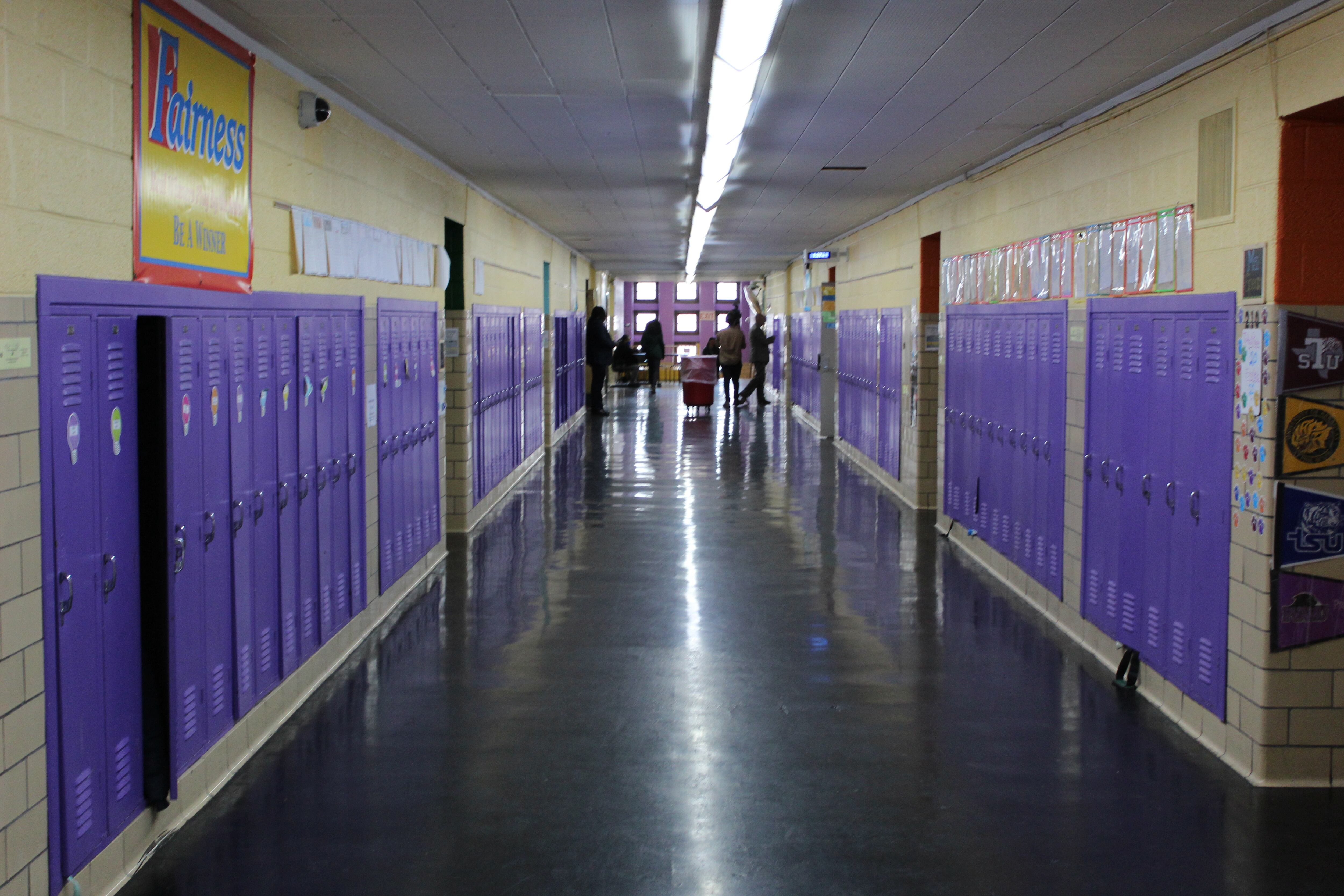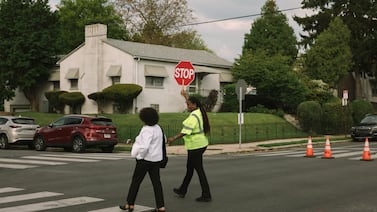Sign up for Chalkbeat Detroit’s free daily newsletter to get the latest on the city’s public school system and Michigan education policy delivered to your inbox.
As Reianna Willis looks ahead to starting her senior year in high school in the fall, the thought of losing her college adviser frightens her.
College advisers and guidance counselors, Reianna said, are the people who provide teenagers with the extra motivation they need to stay on track in school. But her school, East English Village Preparatory Academy at Finney, stands to lose these professionals, along with other support staff and administrators, as the Detroit school district trims its budget to align with declining revenue.
“If there were cuts at my school I feel as if our students would be lost,” she said, adding that students would miss out on critical relationships with staff members. Cutting advisers may improve the budget picture, Reainna said, “but it will worsen our students.”
Nikolai Vitti, the superintendent of the Detroit Public Schools Community District, has tried to reassure community members that the cuts he’s advocating will help ensure the district’s financial stability over the long term. “The staffing reductions are less than a financial necessity but more of a necessary strategic decision to sustain and protect our improvement,” he said.
But for some families and district employees, the latest round of cuts have provoked anxiety, rekindling memories of the deep, devastating cuts the district made during past fiscal crises and the era of state control. Those cuts, including the closure of nearly 200 schools between 2000 and 2015, only ended up compounding the district’s financial problems, leading to plummeting enrollment, an exodus of staff, and even larger deficits and debt.
The fears have surfaced in gatherings of the district’s Executive Youth Council of student leaders, and in the monthly school board meetings, where students, parents and employees of the district have come forward to warn officials against cutting professionals who are seen as critical to students’ success and the district’s goals.
What prompted DPSCD’s proposed budget cuts?
The specter of a return to spiraling cuts is especially worrisome in a district that has achieved six years of relative financial stability after it returned to local control in 2017, thanks to a state legislative initiative that granted the district a fresh start.
The state-appointed emergency managers who ran the district in the past relied on “deep spending cuts (including staffing and teacher salaries), long-term debt to cover annual budget deficits, and delaying required payments,” said a 2019 report from the Citizens Research Council of Michigan detailing the district’s roughly 20-year span of state oversight.
But they had “virtually no success tackling the underlying structural deficit,” the report said.
After 2017, until the pandemic struck, DPSCD began to see rising enrollment and balanced budgets — enough progress that the Detroit Financial Review Commission released DPSCD from state oversight in late 2020, a milestone in the district’s quest to control its budget and finances.
Then, in the midst of the pandemic, the federal government came through with $1.27 billion in aid for the district, buoying its revenue for three years. The added funds made it possible to hire more contracted staff; expand after-school, summer school, and tutoring programs; and take care of long-overdue construction and renovation projects.
But moving into the 2023-24 school year, Vitti said, the district will have to balance its budget relying on recurring revenues, and not one-time federal funding. It will also have to account for the impact of inflation, which has cooled over the past year but remains above historical levels. So instead of being able to fund all of its priorities, and then some, DPSCD will have to pick the ones that it can afford and that will make the biggest impact in the classroom.
“Managing the finances of a steep, long-running enrollment decline is hard enough,” said Bruce Baker, a professor at the University of Miami who focuses on public education financing. But the steep cut in federal funding, coupled with higher costs for maintenance and supplies, compounds that challenge.
In assessing the tradeoffs, DPSCD has chosen to prioritize raising teacher salaries in order to recruit and retain staff and avoid the huge teacher vacancies that it experienced during emergency management.
To satisfy that need, Vitti’s proposed budget would eliminate or shift roughly 300 school and central office positions, including the counselors and college advisers at Reianna’s school. It would also create a $4.2 million budget surplus to address district emergencies, enrollment shifts or other unexpected spending throughout the school year.
“I do not foresee the need to close or consolidate schools in the future for budget reasons,” Vitti said.
Vitti said he believes the district can stick to its priorities and continue to offer what it has promised families in spite of the staffing reductions, and without a hit to enrollment. School principals can choose to fund those positions using Title I money, he noted, and college transition advisers, kindergarten paraprofessionals, and school culture facilitators will have the option to stay with the district in a different role that might be understaffed, such as building substitute, security guard, cafeteria worker, or pre-K paraprofessional. An increase in state per-pupil funding could also help protect some jobs.
On the other hand, if the salary increases go ahead without the staff cuts, the district projects it would swing to an annual deficit and drain its unrestricted funds. And persistent deficits could trigger a return of financial scrutiny from the state.
“If you don’t want us to go back into emergency management or financial review every week, then let us make the necessary budget adjustments so that there’s long term durability and consistent continuity in our district,” said DPSCD board member Corletta Vaughn.
Lisa Card, a DPSCD parent and 20-year veteran educator, said the latest proposed budget cuts reflect a familiar pattern. Initially an art teacher, she went back to school for a master’s in special education when it was clear to her that the district under emergency management was going to cut student programming, including art and music programs.
“We go through these cycles often, and when something is wrong with the budget, it’s always like they go through cutting staff,” Card said. “But I don’t think that that’s the solution.”
Financial goals hang on enrollment numbers
District officials recognize that they can’t merely cut their way to financial stability. The district’s financial strength depends on its ability to rebuild enrollment, which is not even a third of what it was in 2000.
In the past, the district has employed aggressive marketing campaigns in a bid to shore up enrollment and avoid closing school buildings, laying off teachers, and cutting academic programming and support services.
Those campaigns took on increased significance in the wake of the pandemic, during which the district lost 3,000 students. Using its federal COVID relief aid, DPSCD expanded its outreach, home visits and door-to-door canvassing strategies using staff and parent volunteers.
Those tactics enabled the district to bring in 1,000 students, Vitti said.
“Clearly, we are doing something right,” he said.
But there’s still a lot of ground to make up. And now, DPSCD plans to spend less on enrollment strategies. Instead, it will use a smaller budget to market specific schools with available seats and continue to emphasize canvassing through school employees and families. The district is looking to increase enrollment over time by expanding pre-kindergarten programs across the city. As part of its $700 million facility master plan, the district will house those programs at four vacant or underutilized school buildings.
DPSCD’s K-12 enrollment is projected to remain at 48,000 students next year, with a potential bump of 335 pre-kindergarten students, according to Vitti.
Without big enrollment gains, to avoid further budget cuts, Vitti said, the district would have to see an annual increase in per-pupil funding, as well as more equitable state and local school funding. School aid budgets moving through the state Legislature would provide those increases.
“I think we will continue to improve our enrollment but not completely rebound in overall enrollment since the pandemic overnight,” Vitti said.
Vaughn, the school board member, said she thinks the district needs to be more aggressive with its marketing campaign.
“Budgetarily, we’re going in whatever direction the population is going to go,” she said. “If we don’t increase the population, we’ll be right back here next year.”
How will budget cuts affect long-term reforms?
Another key question is how the cuts will affect the district’s progress on its long-term academic goals, which were also thrown off by the pandemic and the shift to online learning. Federal COVID relief aid provided only temporary support, funding tutoring, summer school, and reduced class sizes.
One of Vitti’s long-term reform plans in his first year as superintendent was to hire master teachers to support and coach teachers in math and literacy. He also envisioned having one guidance counselor, college adviser, school culture facilitator, and attendance agent per school.
The aim was to offer broader academic programming and support services that families would otherwise have to leave the district for.
With those positions now threatened, the district says it will look to spread out college advising and school culture and climate work to other school administrators and staff. Guidance counselors for example will take on more work with FAFSA and college applications, while grant funding from the Michigan College Access Network will help ensure that five DPSCD high schools and one career and technical education center can participate in regional college access events.
But some students are skeptical the expanded roles for other educators will provide the same quality and relationship students have with their teachers.
“I truly believe that this would affect students — mostly ninth and 12th graders — because they guide you into the steps right before college,” said De’Loni Perry, a senior at Osborn High School. “It’s not only their help just guiding us but also for the fact that they actually teach us and show us the steps on how to prepare for life after high school. That’s the biggest step you take and most important.”
Asked about that risk, Vitti said: “I do value and understand the relationships that students have with the staff at their school. This is not easy. However, I am confident that the outcomes that matter most for students districtwide will continue to improve with these changes.”
Jaquitta Nelson, a parent and school volunteer at Paul Robeson/Malcolm X Academy, worries that budget cuts will place further pressure on staff members who are already overwhelmed.
Paul Robeson/Malcolm X, according to DPSCD budget documents, could go without its school culture facilitator, dean, and a paraprofessional next school year.
This year alone, Nelson said she’s seen at least four teachers and school administrators at her son’s school retire, some citing burnout. Now she’s bracing for the impact of the district’s cuts on the school.
“How can we help them going forward?” Nelson said.
Ethan Bakuli is a reporter for Chalkbeat Detroit covering Detroit Public Schools Community District. Contact Ethan at ebakuli@chalkbeat.org.






